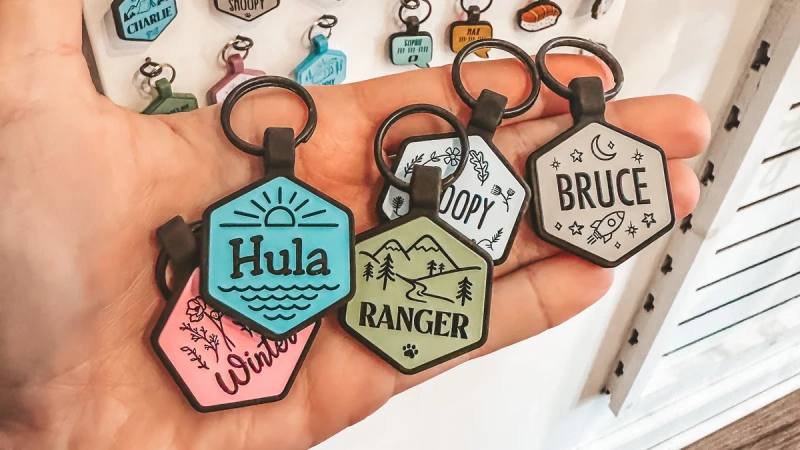What’s the Best Material for Your Dog Tag? Pros, Cons & Use Cases
Introduction
Choosing the right material for a dog tag is not just a matter of style—it’s about your dog’s safety, comfort, and long-term durability. Whether you’re a pet owner looking for the most practical tag for your active Labrador, or a dog accessory business deciding which materials to use for your new product line, understanding the pros and cons of each material can make or break your decision.
This complete guide is built around real use cases and industry data to help you determine what material is best for your dog tag needs. We will compare different materials based on durability, weight, engraving clarity, pricing, and typical usage scenarios. By the end, you’ll know exactly what to choose and why.
1. What Makes a Good Dog Tag Material?
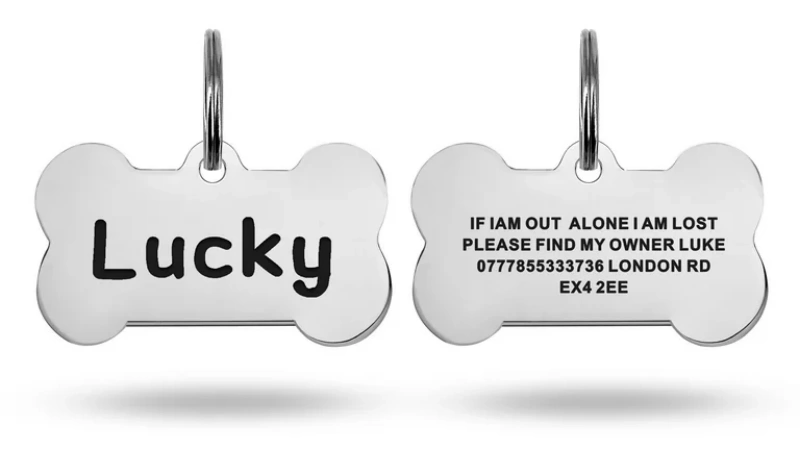
Before diving into material types, it’s important to understand the five key qualities that define a good dog tag:
- Durability: A tag must withstand biting, scratching, rain, mud, and constant movement.
- Engravability: The material should hold clear, legible text or designs that won’t fade over time.
- Weight: Lightweight materials are preferable for small dogs or puppies.
- Comfort and Safety: Smooth edges and non-toxic finishes are essential for daily wear.
- Cost-efficiency: Especially for businesses, finding the right balance between quality and cost is critical.
2. Material Comparison Overview
The table below summarizes the most common materials used in dog tags, along with key attributes that influence their performance.
| Material | Durability (1–5) | Weight | Engraving Clarity (1–5) | Average Cost | Ideal For |
|---|---|---|---|---|---|
| Stainless Steel | 5 | Medium | 5 | Moderate | Active dogs, all-weather use |
| Aluminum | 2 | Light | 3 | Low | Puppies, budget-friendly tags |
| Brass | 4 | Medium | 4 | High | Vintage or premium boutique tags |
| Silicone | 2 | Light | 1 | Moderate | Quiet indoor dogs, sensitive breeds |
| Acrylic/Plastic | 1 | Light | 2 | Very Low | Promotional or seasonal tags |
| Wood | 1 | Light | 2 | Moderate | Rustic or eco-friendly designs |
Note: Cost estimates are based on U.S. and EU bulk manufacturing prices as of Q1 2025. Stainless steel tags typically range from \$0.40–\$0.80 per unit at 500 MOQ; aluminum from \$0.20–\$0.50; brass from \$0.80–\$1.50.
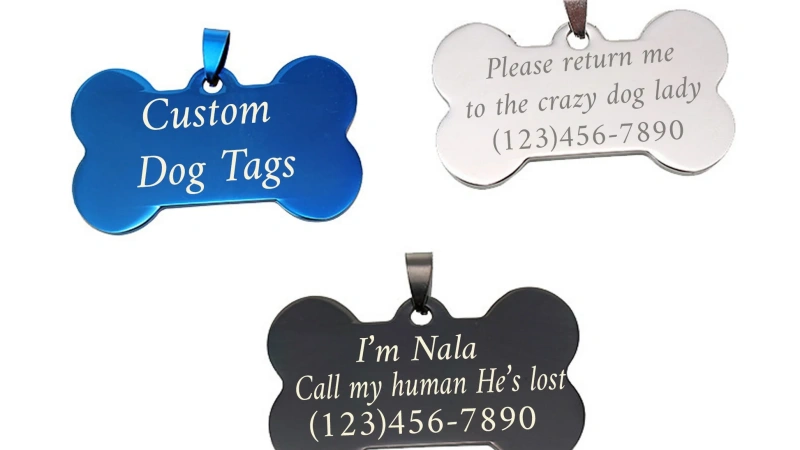
Stainless steel is one of the most popular and reliable materials for dog tags. It offers unmatched durability and engraving precision, making it ideal for dogs that spend a lot of time outdoors or live in humid, wet environments.
Advantages:
- Extremely durable, rustproof, and corrosion-resistant
- Maintains engraving clarity over years of wear
- Works well with laser and rotary engraving
- Resistant to biting and scratching
Disadvantages:
- Heavier than aluminum or plastic, may not suit very small breeds
- Limited in color options unless coated
Best for:
- Military-style tags
- Dogs that swim or hike frequently
- Brands looking for long-term product reliability
A 2024 consumer survey by PetID Market Research found that 68% of professional pet brands prefer stainless steel tags for durability in B2B wholesale lines.
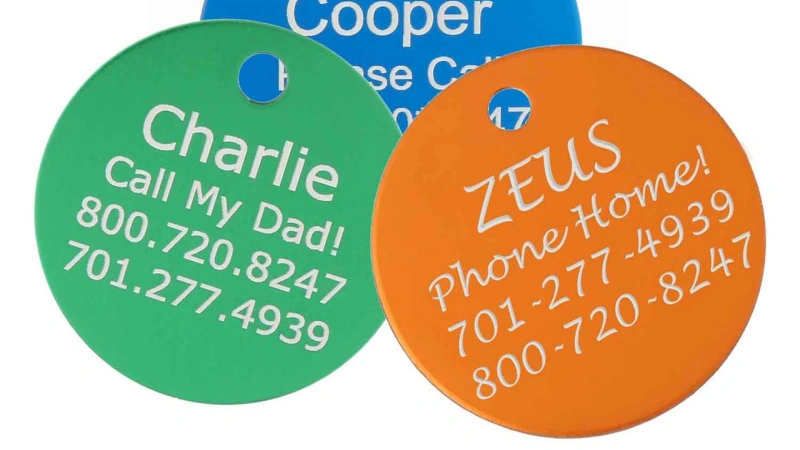
Aluminum is a lightweight and affordable option commonly used in mass-market pet tags. It can be anodized to produce bright colors and is easier to shape into unique forms.
Advantages:
- Extremely lightweight, ideal for puppies or toy breeds
- Colorful anodized finishes (blue, pink, red, etc.)
- Very cost-effective for bulk production
- Easy to custom cut and print
Disadvantages:
- Scratches and dents easily over time
- Engraving may fade within 6–12 months with active dogs
- Not recommended for rough outdoor conditions
Best for:
- Lightwear tags
- Fashion or seasonal pet accessory lines
- Budget-conscious bulk orders
Data from Wedogy clients in 2023 shows aluminum tags were chosen for 72% of seasonal product launches or influencer collaboration drops due to cost-effectiveness and color flexibility.
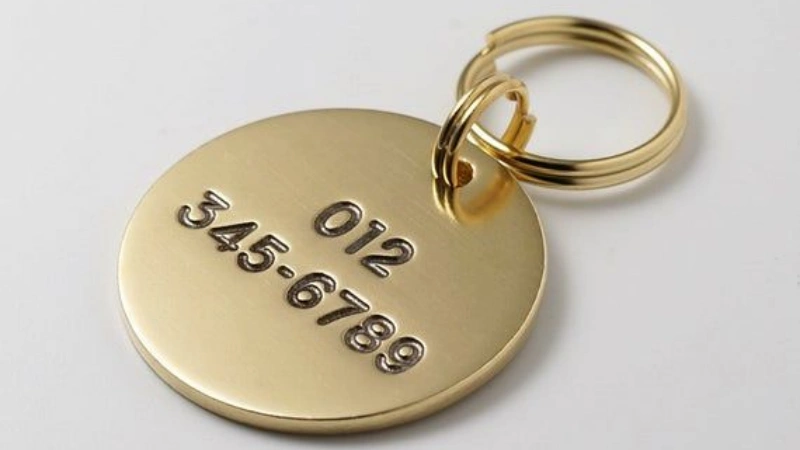
Brass offers a classic, vintage look that appeals to premium brands and customers seeking a timeless aesthetic. While not as durable as stainless steel, it holds engraving detail well and develops a patina over time, adding to its character.
Advantages:
- High-end, traditional appearance
- Accepts deep engraving for long-lasting legibility
- Adds luxury value to boutique pet products
- Visually appealing patina as it ages
Disadvantages:
- Can tarnish or darken over time
- Medium weight, may not suit small breeds
- More expensive than aluminum or plastic
Best for:
- Premium pet accessory brands
- Rustic or heritage-themed product lines
- Older or calm dogs with minimal wear on tags
A brass tag is often priced between \$1.00–\$2.00 in boutique stores and is perceived as a luxury item in consumer testing panels.
![]()
Silicone is soft, flexible, and completely silent—a great feature for pet owners who dislike the clinking sound of metal tags. While it doesn’t support sharp engraving, it can be molded or UV-printed for basic personalization.
Advantages:
- Lightweight and chew-safe for dogs
- Completely silent during movement
- Waterproof and flexible
- Great for night use or quiet environments
Disadvantages:
- Not engravable in traditional sense; prints may fade
- Low resistance to chewing by strong-jawed breeds
- Limited professional or luxury appeal
Best for:
- Apartment-dwelling dogs
- Pets sensitive to sound
- Casual or novelty product lines
Many Etsy sellers reported that silicone dog tags made up over 30% of their “quiet home” orders in 2024, particularly in urban regions.
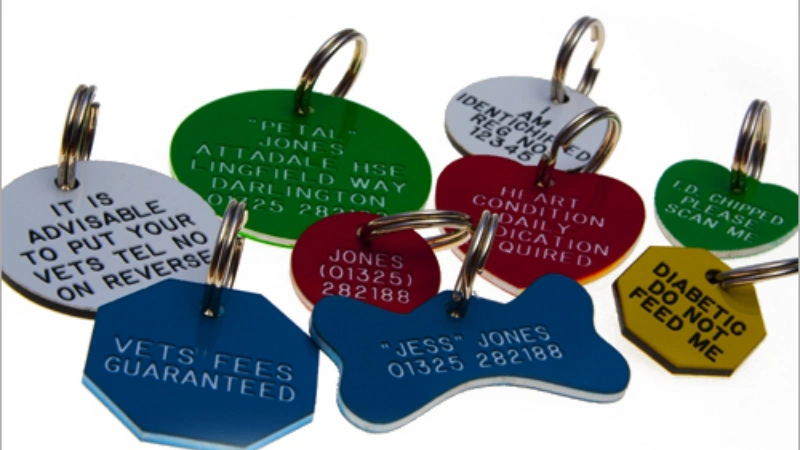
Acrylic and plastic dog tags are often chosen for their bright appearance and ultra-light weight. These materials are especially popular for fun designs, novelty tags, or low-cost giveaways, but they are not built for durability.
Advantages:
- Extremely lightweight, ideal for very small dogs or cats
- Available in a wide range of colors and shapes
- Inexpensive to manufacture and customize
- Good for laser cutting and UV printing
Disadvantages:
- Not suitable for active dogs or outdoor use
- Can crack or scratch easily
- Print or engraving may wear off in 3–6 months
Best for:
- Promotional items or gift-with-purchase tags
- Fashion-forward seasonal collections
- Customers looking for visual flair at low cost
For small brands launching their first dog tag product, acrylic tags can be an ideal low-risk entry point, with production costs starting as low as \$0.10 per unit in high-volume runs.
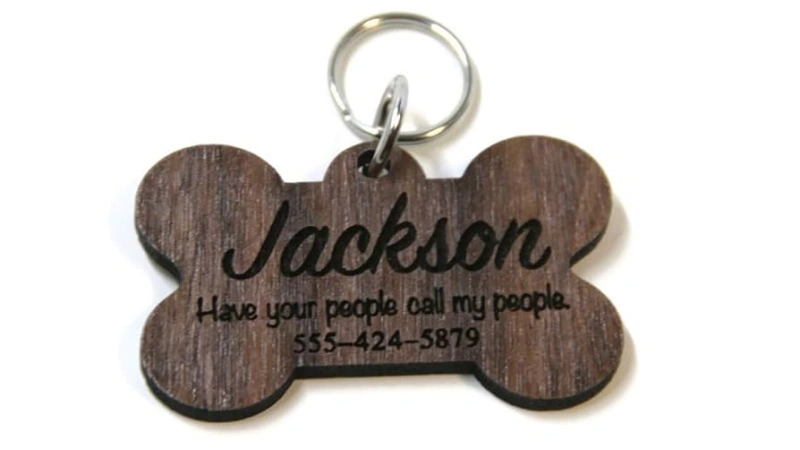
Wood dog tags offer a natural, rustic aesthetic that appeals to eco-conscious buyers and niche brands. While not weather-resistant, they stand out as an artisanal, design-focused product.
Advantages:
- Eco-friendly and biodegradable
- Lightweight and naturally textured
- Distinctive appearance for rustic or handmade markets
- Can be laser engraved with good visual contrast
Disadvantages:
- Not water-resistant, may warp or stain
- Easily damaged by biting or weather exposure
- Limited production scalability
Best for:
- Indoor pets or decorative use
- Handmade product lines or Etsy-style shops
- Eco-conscious branding and packaging
Wood dog tags pair well with kraft paper packaging and natural hemp collars. Wedogy has supported custom OEM orders of wood tags for brands targeting zero-waste pet lifestyles.
9. Specialized and Emerging Materials
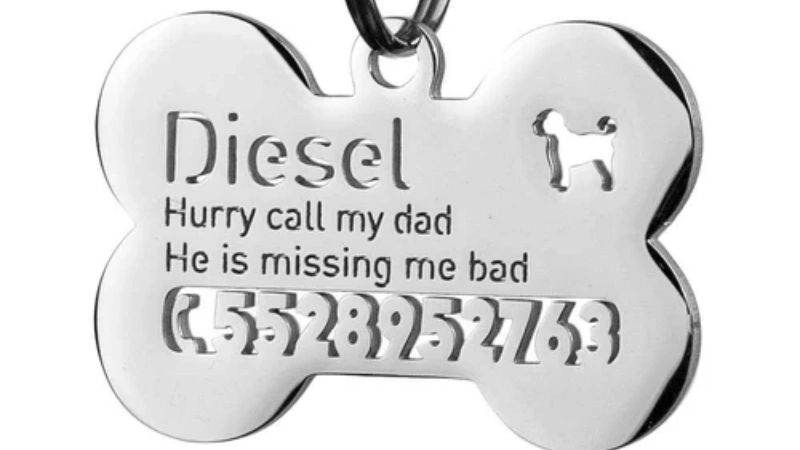
Some pet brands and innovators are exploring newer materials that offer unique functionality or aesthetics. While not as common, they may serve specific niche needs.
Titanium
- Pros: Stronger and lighter than stainless steel, corrosion-proof
- Cons: Expensive, not suitable for budget lines
- Best for: Premium adventure brands or military-grade products
Leather
- Pros: Soft and stylish, high-end appearance
- Cons: Absorbs moisture, degrades over time
- Best for: Decorative collars or vintage themes
Epoxy-coated or Glow-in-the-Dark Tags
- Pros: Visibly stylish and good for night use
- Cons: Can wear down easily if unprotected
- Best for: Night walks, safety-enhanced designs
NFC/Smart Tags
- Pros: Embedded chips allow tap-to-scan owner info
- Cons: Higher unit cost, relies on user tech adoption
- Best for: High-tech brands, urban dog owners
According to 2024 Pet Wearables Market data, smart tag usage increased by 18% YoY in North America and is projected to grow further with Gen Z pet ownership trends.
10. Choosing the Right Material Based on Scenarios
To help you decide faster, here’s a reference guide by usage scenario:
| Scenario | Recommended Material |
|---|---|
| Hiking, outdoor adventures | Stainless Steel, Titanium |
| Small dogs and puppies | Aluminum, Silicone |
| Quiet home or night walks | Silicone, Glow tags |
| Eco-conscious pet owners | Wood, Recycled Aluminum |
| Stylish and vintage collections | Brass, Leather |
| Bulk promotional giveaways | Plastic, Aluminum |
| Smart/digital identity integration | NFC Tags, Epoxy-Coated |
| Premium boutique dog products | Brass, Titanium |
Selecting material based on your audience is just as important as based on the dog. Breed size, owner preference, lifestyle, and brand positioning all influence the ideal match.
11. Wedogy’s Material Options and Custom Manufacturing Support
At Wedogy, from design to packaging to help you to build your dog tag business, we offer full OEM manufacturing services for dog tags in the following materials:
- Stainless Steel: Available in brushed, mirror-polish, or matte finishes.
- Aluminum: Color-anodized options, laser and UV engraving supported.
- Brass: Hand-polished and patina finishes available.
- Silicone: Molded designs, custom colors, glow-in-the-dark variants.
- Plastic & Acrylic: Full-shape cutting, vibrant UV printing.
- Wood: Bamboo, walnut, and birch wood available with eco-laser engraving.
We support MOQ as low as 100 pcs, and free sampling for bulk orders. Our factory also offers value-added services including:
- Silent tag attachments
- Custom packaging (boxes, hang tags, labels)
- QR-code or NFC integration
- Multi-language tag text production
12. Conclusion: What’s the Best Dog Tag Material?
The answer depends on your dog’s lifestyle, your brand values, and your target customer segment.
- If you need maximum durability and clarity, go with stainless steel.
- For lightweight, cost-effective options, aluminum is ideal.
- For luxury, vintage appeal, consider brass.
- If you need silence and flexibility, silicone wins.
- For eco-conscious or niche storytelling, explore wood or acrylic.
- And if your brand is tech-forward, NFC or smart tags are the future.
No matter what material you choose, Wedogy is here to support your journey from design to production. Contact us to get your first sample or request a material consultation—we help hundreds of small pet brands turn ideas into premium-quality dog tags.


